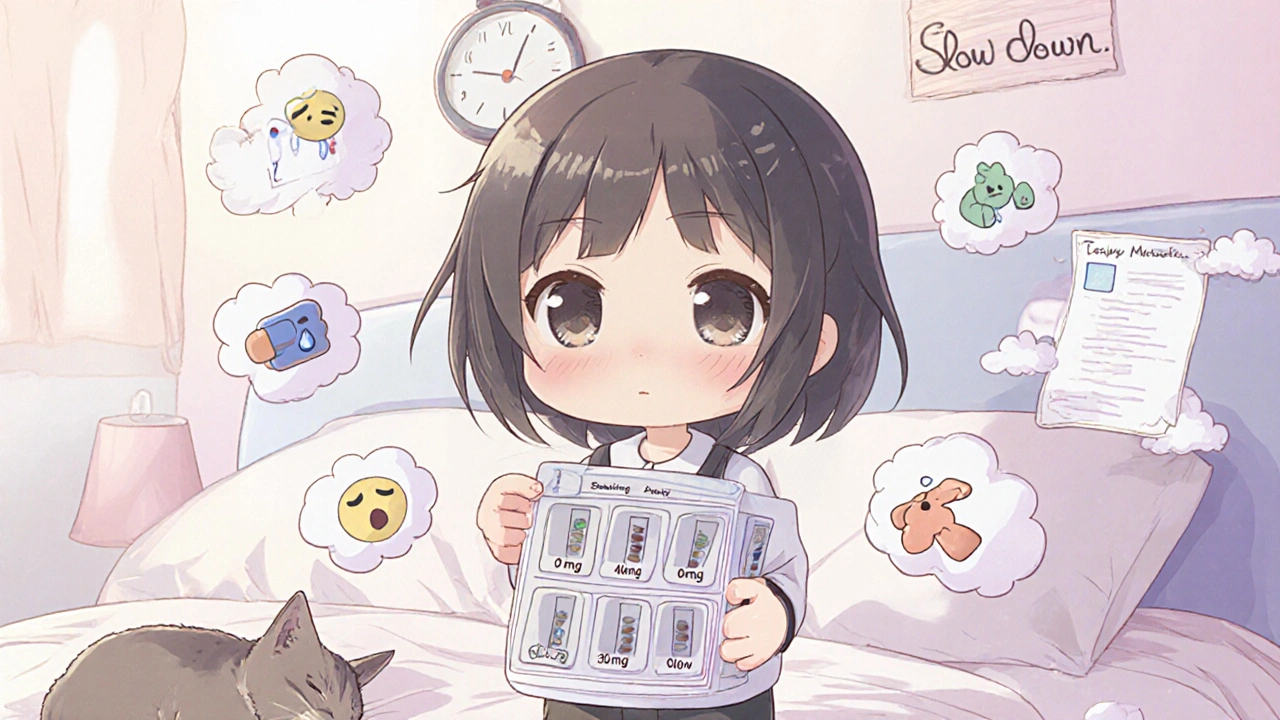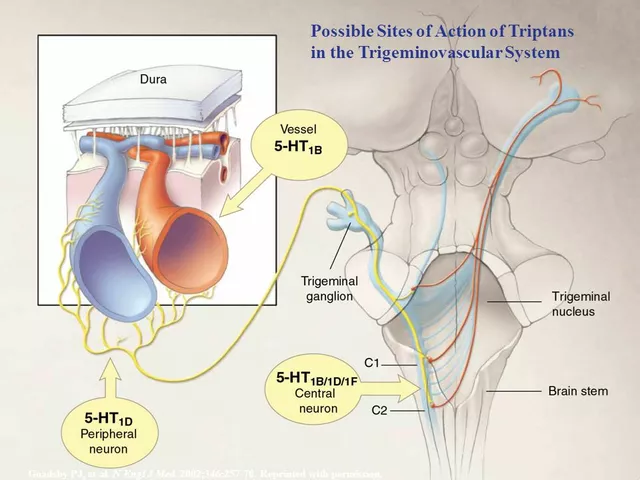Corticosteroid Tapering Calculator
Use this tool to estimate a safe tapering schedule based on your current medication and treatment duration. Always consult your doctor before making any changes to your steroid regimen.
The American College of Rheumatology recommends a gradual taper to prevent adrenal insufficiency, which affects nearly 4 out of 5 patients who stop suddenly.
Stopping corticosteroids like prednisone isn’t as simple as taking your last pill and calling it done. If you’ve been on these meds for more than a few weeks, your body has adjusted-your adrenal glands have slowed or stopped making cortisol because the drug is doing the job for them. When you quit too fast, your body doesn’t have time to wake up again. That’s when withdrawal hits: crushing fatigue, muscle aches, nausea, joint pain, and even mood crashes. It’s not in your head. It’s biology.
Why Tapering Isn’t Optional
Corticosteroids suppress your hypothalamic-pituitary-adrenal (HPA) axis. That’s the system that tells your body when to make cortisol-the natural hormone that manages stress, blood sugar, and inflammation. When you take prednisone or another glucocorticoid for more than 2-4 weeks at doses above 7.5 mg daily, your adrenals go quiet. Abruptly stopping means your body has no cortisol to fall back on. According to the Mayo Clinic, 78% of patients who stop suddenly develop withdrawal symptoms. That’s nearly 4 out of 5 people. Tapering isn’t just about avoiding discomfort. It’s about preventing adrenal insufficiency-a medical emergency where your body can’t respond to stress. Without enough cortisol, even a minor infection or injury can trigger a life-threatening drop in blood pressure, low sodium, or dangerously low blood sugar. The goal isn’t just to feel better. It’s to stay alive.How Fast Should You Taper?
There’s no one-size-fits-all schedule. It depends on how long you’ve been on steroids, your dose, and what condition you’re treating. But here’s how it generally breaks down:- If you’re on more than 20 mg of prednisone daily, you can start by dropping 5 mg every 3-7 days until you hit 15 mg.
- Once you’re at 15 mg or lower, slow down. Drop by 1 mg every 1-2 weeks.
- Below 5 mg, go even slower-sometimes 0.5 mg every 1-2 weeks. This is where most people run into trouble.
What Withdrawal Symptoms Actually Look Like
Withdrawal isn’t just “feeling tired.” It’s a cluster of symptoms that often get mistaken for something else:- Physical: Severe fatigue that doesn’t improve with rest, muscle weakness, joint pain, nausea, loss of appetite.
- Psychological: Anxiety, depression, irritability, insomnia, brain fog.
- Physiological: Low blood pressure when standing (orthostatic hypotension), dizziness, low blood sugar.

What Works to Manage Symptoms
There’s no magic pill to make withdrawal disappear. But research shows these strategies help a lot:- Exercise: Just 20 minutes of walking or warm-water pool therapy five days a week cuts musculoskeletal pain by 42%, according to a 2022 Rheumatology Network study. Movement helps your body adjust.
- Therapy: Cognitive behavioral therapy (CBT) reduced anxiety and depression from steroid withdrawal by 68% in a 2023 trial by the American Addiction Centers.
- Sleep and diet: Getting 7-9 hours of sleep, cutting caffeine to under 200 mg a day (about two cups of coffee), and eating a Mediterranean-style diet (fish, vegetables, nuts, olive oil) lowered symptom severity by 55% in a Mayo Clinic registry of over 1,200 patients.
- Support: Patients who had a structured taper plan with regular check-ins were 89% more satisfied than those who tapered “as needed.”
Red Flags and When to Call Your Doctor
Even with the best plan, things can go wrong. Watch for these signs:- Your symptoms get worse after a dose reduction-even if you’re still above 5 mg.
- You develop dizziness, fainting, or vomiting.
- Your blood pressure drops when you stand up.
- You feel worse after a minor illness, injury, or dental work.
Why So Many People Struggle
A 2023 analysis of Reddit’s r/Prednisone community (over 12,500 members) found that 68% experienced unexpected symptoms-even with a prescribed taper. Why? Because many doctors don’t follow guidelines. Only 43% of primary care physicians use evidence-based tapering protocols. Gastroenterologists and rheumatologists do better, but even then, 63% of patients report inconsistent advice between specialists. Patients also report poor education. Many aren’t told what to expect, how long symptoms might last, or what to do if they feel worse. A Drugs.com review of 3,872 patients showed average withdrawal lasted 22.7 days-but 18% had symptoms longer than 60 days. That’s two months of feeling like you’re stuck in a fog.
What You Can Do Right Now
If you’re tapering-or planning to-here’s your action list:- Ask your doctor for a written taper schedule with exact doses and dates. Don’t rely on memory.
- Get an emergency steroid card. It should list your max physiological dose (usually 20-30 mg hydrocortisone equivalent) in case of trauma or illness.
- Track your symptoms daily. Note fatigue, pain, mood, sleep, and blood pressure (if you have a home monitor).
- Start walking or swimming now. Even light movement helps your body adapt.
- Limit caffeine. It worsens anxiety and disrupts sleep when your body is already stressed.
- Find a support group. Reddit’s r/Prednisone or the Arthritis Foundation’s forums can help you feel less alone.
The Future of Tapering
New tools are emerging. Mayo Clinic launched a digital tapering assistant in March 2024 that cut complications by 37% in a pilot study. Researchers are testing saliva tests to measure your cortisol awakening response-a natural spike in the morning-and using it to adjust taper speed. Early results show 82% accuracy in predicting recovery time. In the next few years, AI-driven systems integrated with electronic health records will likely become standard. They’ll analyze your age, dose, duration, symptoms, and lab results to suggest personalized taper plans. But for now, the best tool you have is awareness. Know your body. Track your progress. Speak up if something feels off.Final Thought
Tapering off corticosteroids is one of the most underrated challenges in chronic illness care. It’s not a quick fix. It’s a slow relearning process-your body relearning how to be itself again. It takes patience. It takes support. And it takes a doctor who understands the science, not just the script.Don’t rush it. Don’t ignore the signs. And don’t feel guilty if you need to pause or go back a little. Your health isn’t a race. It’s a recovery.
How long does corticosteroid withdrawal last?
For most people, withdrawal symptoms last between 2 and 6 weeks, but they can linger for months-especially if you were on high doses for over a year. The duration depends on how long you took the medication, your dose, and how fast you tapered. Some patients report fatigue or joint pain for up to 8 weeks, and 18% of users in one study had symptoms beyond 60 days. Slow tapering reduces both severity and duration.
Can you stop prednisone cold turkey?
No. Stopping prednisone suddenly after taking it for more than 2-4 weeks can trigger adrenal insufficiency, a medical emergency. Symptoms include severe fatigue, dizziness, vomiting, low blood pressure, and confusion. In rare cases, it can be fatal. Always taper under medical supervision, even if you feel fine.
What’s the difference between withdrawal and a disease flare?
Withdrawal symptoms are general: fatigue, body aches, nausea, mood changes, and sleep issues. A disease flare is specific to your condition. For example, if you have rheumatoid arthritis, a flare means swollen, hot joints. If you have Crohn’s, it means diarrhea, abdominal pain, or bloody stools. If you’re unsure, check your symptoms against your usual flare pattern and consult your doctor. Blood tests can help distinguish between the two.
Do I need blood tests during tapering?
Not always, but they’re helpful if you have symptoms. Your doctor may order a cortisol blood test or an ACTH stimulation test (using cosyntropin) to check if your adrenal glands are recovering. A peak cortisol level above 400-500 nanomol/L after the test means your HPA axis is working. If it’s low, you may need to slow your taper or temporarily increase your dose.
Can I use natural remedies to help with withdrawal?
There’s no proven natural substitute for cortisol. But certain lifestyle changes help your body recover: sleep, low-impact exercise, reducing caffeine, eating anti-inflammatory foods, and managing stress. Some people report benefits from adaptogens like ashwagandha, but there’s no solid evidence they help with steroid withdrawal. Never replace your prescribed taper with supplements-always talk to your doctor first.
What should I do if I feel worse after reducing my dose?
Don’t panic. It’s common. Contact your doctor. You may need to hold your current dose for another week or two, or temporarily increase it by 1-2.5 mg. Pushing through can make symptoms worse and delay recovery. Slowing down isn’t failure-it’s smart management. Many successful tapers involve small, temporary adjustments.
Is it normal to feel anxious or depressed during tapering?
Yes. Corticosteroids affect brain chemistry, and when you reduce them, your brain has to readjust. Anxiety, irritability, and low mood are common withdrawal symptoms. Cognitive behavioral therapy (CBT) has been shown to reduce these symptoms by 68%. Talking to a therapist, practicing mindfulness, or joining a support group can make a big difference.
How do I know if my taper is too fast?
If you start experiencing withdrawal symptoms (fatigue, aches, nausea, dizziness) after a dose reduction, your taper is likely too fast. The general rule: if symptoms appear, pause the taper for 1-2 weeks. If they improve, try reducing again, but slower. If they don’t improve, contact your doctor. Your body is telling you it needs more time.
Should I carry an emergency steroid card?
Yes. If you’ve taken corticosteroids for more than 2-4 weeks, you should carry a card or medical alert bracelet listing your maximum physiological dose (usually 20-30 mg hydrocortisone equivalent). In case of trauma, surgery, or serious illness, you may need a stress dose of steroids to prevent adrenal crisis. This is standard advice from the Endocrine Society and the American College of Rheumatology.
Can I taper off corticosteroids on my own?
No. Tapering must be done under medical supervision. Even if you feel fine, your adrenal glands may not be recovered. Doctors use lab tests, symptom tracking, and experience to adjust your plan. Tapering alone increases the risk of adrenal insufficiency, disease flare, and prolonged withdrawal. Always work with your healthcare team.


